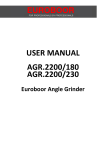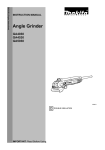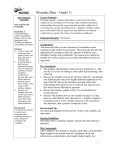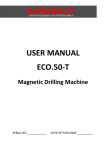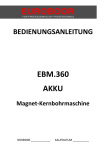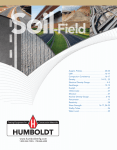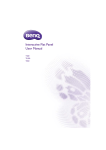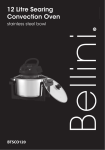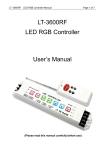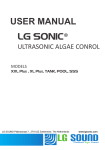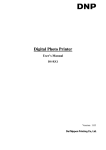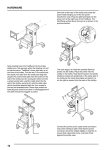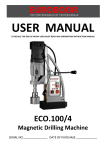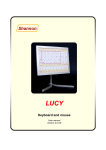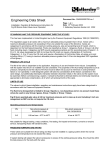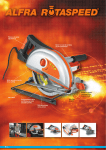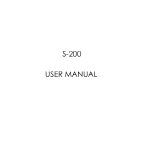Download USER MANUAL EDG.600 EUROBOOR
Transcript
EUROBOOR FOR PROFESSIONALS BY PROFESSIONALS USER MANUAL EDG.600 Electric Die Grinder Congratulations on your purchase of the Euroboor EDG.600 Electric Die Grinder. Before operating your new Die Grinder, please read all instructions first. These include the Operator’s Manual and Warning Label on the unit itself. With proper use, care and maintenance, your model will provide you with years of effective performance. TO REDUCE THE RISK OF INJURY USER MUST READ AND UNDERSTAND ALL INSTRUCTIONS EUROBOOR BV Kryptonstraat 110 2718 TD Zoetermeer Netherlands T +31 79 361 49 90 F +31 79 361 49 89 [email protected] www.euroboor.com Symbol Term, meaning Explanation Read documentation Be absolutely sure to read the enclosed documentation such as the Instruction Manual and the General Safety Instructions. Wear ear protection Use ear protection during operation. Wear eye protection Use eye-protection during operation. Danger/warning/caution Observe the information in the adjacent text! European conformity symbol Confirms the conformity of the power tool with the directives of the European Community. Product with basic insulation and exposed (touchable), conductive parts additionally connected to the protective earth conductor. Class of protection I mm Millimeter Unit of measure for length, width, height or depth kg Kilogram Unit of measure for the mass V Volt Unit of measure for the electric voltage A Ampere Unit of measure for the electric current intensity W Watt Unit of measure for the output N Newton Unit of measure for the force min Minutes Unit of measure for the time no No-load speed Revolution speed at no-load 1/min per minute Unit of measure for number of revolutions, strokes, impacts or oscillations per minute. Specification: Further safety instructions for all operations Kickback and Related Warnings Kickback is a sudden reaction to a pinched or snagged rotating wheel, backing pad , brush or any other accessory. Pinching or snagging causes rapid stalling of the rotating accessory which in turn causes the uncontrolled power tool to be forced in the direction opposite of the accessory’s rotation at the point of the binding. For example, if an abrasive wheel is snagged or pinched by the workpiece, the edge of the wheel that is entering into the pinch point can dig into the surface of the material causing the wheel to climb out or kick out .The wheel may either jump toward or away from the operator, depending on direction of the wheel’s movement at the point of point of pinching. Abrasive wheels may also break under these conditions. Kickback is the result of power tool misuse and /or incorrect operating procedures or conditions and can be avoided by taking proper precautions as given below. a) Maintain a firm grip on the power tool and position your body and arm to allow you to resist kickback forces . Always use auxiliary handle, if provided, for maximum control over kickback or torque reaction during start-up. The operator can control torque reactions or kickback forces, if proper precautions are taken. b) Never place your hand near the rotating accessory. Accessory may kickback over your hand. c) Do not position your body in the area where power tool will move if kickback occurs. Kickback will propel the tool in direction opposite to wheel’s movement at the point of snagging. d) Use special care when working corners, sharp edges etc. Avoid bouncing and snagging the accessory .Corners, sharp edges or bouncing have a tendency to snag the rotating accessory and cause loss of control or kickback. e) Do not attach a saw chain woodcarving blade or toothed saw blade. Such blades create frequent kickback and loss of control. f) Additional safety instructions for grinding and cutting-off operations g) Safety Warnings Specific for Grinding and Abrasive Cutting-Off Operations: h) Use only wheel types that are recommended for your power tool and the specific guard designed for the selected wheel. Wheels for which the power tool was not designed cannot be adequately guarded and are unsafe. i) The guard must be securely attached to the power tool and positioned for maximum safety , so the least amount of wheel is exposed towards the operator. The guard helps to protect operator from broken wheel fragments and accidental contact with wheel. j) Wheels must be used only for recommended applications. For example: do not grind with the side of cut-off wheel . Abrasive cut-off wheels are intended for peripheral grinding, side forces applied to these wheels may cause them to shatter . k) Always use undamaged wheel flanges that are of correct size and shape for your selected wheel. Proper wheel flanges support the wheel thus reducing the possibility of wheel breakage. Flanges for cut-off wheels may be different from grinding wheel flanges. l) Do not use worn down wheels from larger power tools . Wheel intended for larger power tool is not suitable for the higher speed of a smaller tool and may burst . Additional safety instructions for cutting-off operations Additional Safety Warnings Specific for Abrasive Cutting-off Operations: a. Do not “jam” the cut-off wheel or apply excessive pressure .Do not attempt to make an excessive depth of cut. Overstressing the wheel increases the loading and susceptibility to twisting or binding of the wheel in the cut and the possibility of kickback or wheel breakage. b. Do not position your body in lime with and behind the rotating wheel. When the wheel, at the point of operation, is moving away from your body , the possible kickback may propel the spinning wheel and the power tool directly at you . c. When wheel is binding or when interrupting a cut for any reason, switch off the power tool and hold the power tool motionless until the wheel comes to a complete stop. Never attempt to remove the cut-off wheel from the cut while the wheel is in motion otherwise kickback may occur. Investigate and take corrective action to eliminate the cause of wheel binding. d. Do not restart the cutting operation in the workpiece . Let the wheel reach full speed and carefully the cut. The wheel may bind, walk up or kickback if the power tool is restarted in the workpiece. e. Support panels or any oversized workpiece to minimize the of wheel pinching and kickback. Large workpieces tend to sag under their own weight. Supports must be placed under the workpiece near the line of cut and near the edge of the workpiece on both sides of the wheel. f. Use extra caution when making a “pocket cut ” into existing walls or other blind areas . The protruding wheel may cut gas or water pipes, electrical wiring or objects that can cause kickback. Check that speed marked on the wheel is equal to or about of the rated speed of the grinder. Ensure that the wheel dimensions are compatible with the grinder. Abrasive wheels shall be stored and handed with care in accordance with manufacturer's instructions. Inspect the grinding wheel before use, do not use chipped, cracked or otherwise defective products. Ensure that mounted wheels and points are fitted in accordance with the manufacture's instructions. Ensure that the abrasive product is correctly mounted and tightened before use and run the tool at no-load for 30's in a safe position, stop immediately if there are considerable vibrations or other defects are detected. if this condition occurs, check the machine to determine the causation. Do not use it cutting off steel for side grinding. Ensure that ventilation opening clear when working in dusty condition. if it is necessary to clear the dust make sure that the Switch off the grinder and disconnect it away the power point. Introduction This tool is intended for grinding metal materials without the use of water. Do not apply pressure on the tool; let the fit speed of the grinding point do the work Read and save this instruction manual. Operating Controls: 1. Collect nut 2. Spindle 3. Spindle collar 4. Ventilation slots 5. Switch 6. Speed controller 7. Grinding point 8. Spanner 9. Auxiliary handle 10. Spindle lock pin







